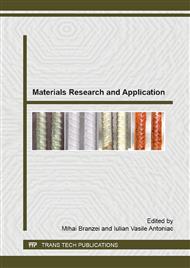[1]
S.D. Washko, G. Aggen, ASM Handbook, Vol. 1, Properties and Selection: Irons, Steels, and High-Performance Alloys, ASM International, Materials Park, OH, (1999).
DOI: 10.31399/asm.hb.v01.9781627081610
Google Scholar
[2]
M.H. Ashby, H. Shercliff, D. Cebon, Materials Engineering, Science, Processing and Design, Butterworth-Heinemann, Oxford, UK, (2007).
Google Scholar
[3]
ASM Handbook, Vol. 6, Welding, Brazing and Soldering, ASM International, Materials Park, OH, (1993).
Google Scholar
[4]
K.M. Ralls, T.H. Courtney, J. Wulff, Introduction to Materials Science and Engineering, John Wiley and Sons, New York, (1976).
Google Scholar
[5]
W.F. Hosford, R.M. Caddell, Metal Forming: Mechanics and Metallurgy, Prentice-Hall, Englewoods Cliffs, NJ, (2003).
Google Scholar
[6]
M.M. Farag, Selection of Materials and Manufacturing Processes for Engineering Design, Prentice-Hall, Englewood Cliffs, NJ, (1999).
Google Scholar
[7]
H. Nordberg, Mechanical Properties of Austenitic and Duplex Stainless Steels, in Stainless Steels Symposium, Innovation Stainless Steel, Florens, (1993).
Google Scholar
[8]
ASM Handbook, Vol. 2, Properties and Selection: Nonferrous Alloys and Special-Purpose Materials, ASM International, Materials Park, OH, (2010).
DOI: 10.31399/asm.hb.v02.9781627081627
Google Scholar
[9]
W.F. Smith, J. Hashemi, Principles of Materials Science and Engineering, 4th edition, McGraw-Hill Book Company, New York, (2006).
Google Scholar
[10]
ASM Handbook, Vol. 2, Metal-Matrix Composites, Properties and Selection: Nonferrous Alloys and Special-Purpose Materials, ASM International, Materials Park, OH, (1992).
DOI: 10.31399/asm.hb.v02.9781627081627
Google Scholar
[11]
M.F. Ashby, D.R.H. Jones, Engineering Materials 1, An Introduction to Their Properties and Applications, 3rd edition, Butterworth-Heinemann, Woburn, UK, (2005).
Google Scholar
[12]
G. Chakraborty, N. Kumar, C.R. Das, S.K. Albert, A.K. Bhaduri, S. Dash, A.K. Tyagi, Study on microstructure and wear properties of different nickel base hardfacing alloys deposited on austenitic stainless steel, Surface & Coatings Technology 244 (2014).
DOI: 10.1016/j.surfcoat.2014.02.013
Google Scholar
[13]
N.E. Dowling, Mechanical Behavior of Materials, 2nd edition, Prentice Hall PTR, Paramus, NJ, (1998).
Google Scholar
[14]
N. Yüksel, S. Sahin, Wear behavior–hardness–microstructure relation of Fe–Cr–C and Fe–Cr–C–B based hardfacing alloys, Materials and Design 58 (2014) 491–498.
DOI: 10.1016/j.matdes.2014.02.032
Google Scholar
[15]
M.F. Buchely, J.C. Gutierrez, L.M. Leon, A. Toro, The effect of microstructure on abrasive wear of hardfacing alloys, Wear 259 (2005) 52–61.
DOI: 10.1016/j.wear.2005.03.002
Google Scholar


